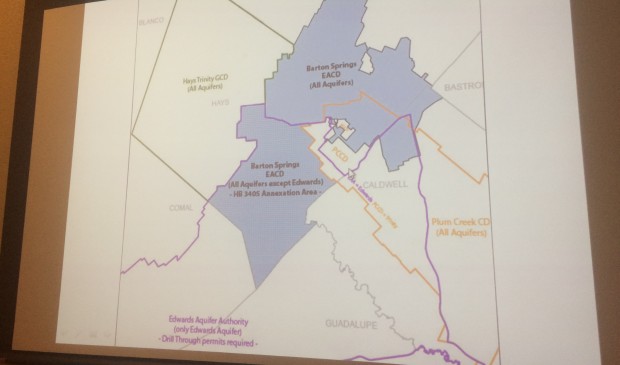Conservation district talks flow for Hays County
Monday, June 15, 2015 by
Courtney Griffin Staff with the Barton Springs/Edwards Aquifer Conservation District spent more than an hour briefing board members on House Bill 3405’s implications Thursday. The long-anticipated bill could nearly double the district’s jurisdiction, and staff is presuming months of increased work as they wait for Gov. Greg Abbott’s signature.
HB 3405 will immediately incorporate about 200 square miles of Hays County under BSEACD’s regulating authority if signed or left blank by June 21. Stemming from concerns that arose after Houston-based water supplier Electro Purification revealed plans to pump an estimated 3.5 million gallons of water per day from seven wells in the Trinity Aquifer, the bill brings governmental control to a previously unchecked area.
“I almost hope he leaves it unsigned,” said John Dupnik, BSEACD’s general manager, noting that Abbott’s signature would immediately put things into motion. “Just so we have more time to prepare.”
Dupnik told board members that HB 3405’s final version has succeeded in tackling several tricky problems, including concisely spelling out jurisdictions in a convoluted area that contains up to three regulating authorities: the Plum Creek Conservation District, the Edwards Aquifer Authority and now BSEACD.
Once the bill is implemented, BSEACD will regulate all aquifers besides the Edwards in the new area.
The Edwards Aquifer Authority has regulated the majority of the area since 1993 and monitors most of the current well and water use within Hays County.
But the Trinity Aquifer lies below the Edwards Aquifer, Dupnik said. Around three dozen deeper-drilling wells, including seven of EP’s wells, tap into the area’s unregulated Trinity Aquifer now and need to be monitored by BSECD, he said.
Affected residents will have 90 days to file for a temporary permit for wells that are currently permitted or contracted once the bill becomes law. BSEACD staff said the temporary permits will be issued for the wells’ maximum production capacity, which differs from the district’s regular permits that determine permitted water-use levels based on the holistic impact to BSEACD’s aquifers.
“This is the most controversial section of the bill, and (lawmakers) went back and forth with various iterations of this portion,” Dupnik told the board.
Once well owners apply for a temporary permit, a twofold application will begin the regular permitting process, Dupnik said. Staff plans to issue temporary permits within 30 days and regular permits within 180 days.
The bill’s language states that new regular permits can be reduced or rejected only if a well’s production capacity inhibits the district’s long-term water-level goal — known as the Groundwater Management Area’s “desirable future conditions” — or if it causes unreasonable impacts to existing wells.
Dupnik told the Austin Monitor that under the terms of this bill, if EP applies for a temporary permit within 90 days of the effective date, the permitting process will allow the company to operate all of its wells at their maximum capacity. He said a regular permit should be issued within 180 days to better govern water use, but more time can also be allotted if EP contests BSEACD’s ruling.
To lessen or reject the permit, BSEACD will also need to prove that EP’s production causes harm to surrounding wells or to the future of the Groundwater Management Area’s water supply; the Trinity Aquifer area should not dip below 25 feet during average conditions, Dupnik said.
Senior Hydrologist Brian Smith said BSEACD staff has already begun technical evaluations of EP’s wells to try to answer questions about environmental impact, but it will take some time.
Legislators have also placed all of the newly incorporated area under a fee cap of 17 cents per thousand gallons of water use, which is less than current BSEACD fees. The district can currently charge its users up to 54 cents per thousand gallons of water use, a fee that is determined by the Lower Colorado River Authority, Dupnik said.
“When it comes time to implement this, we should let people know that this is not exactly our idea of fair, it’s just what the legislature gave us,” added Vice President and Precinct 5 Board Member Craig Smith, referring to the fee cap.
The bill maintains BSEACD’s five-member board, though there had been talk of raising that number to seven. That means board members will have to approve redrawn precinct lines before July 2016. Staff said they plan to begin tackling redistricting in January after permit mayhem has died down.
“We need to do hearings, and most of the (board members) in the past have wanted to meet with the drawers and look at different plans the board will consider,” said attorney Bill Dugat, who is the district’s legal counsel.
Dugat said that redistricting is required in order to incorporate at least two precincts with territories in the city of Austin and maintain equally populated districts.
Map presented at BSEACD’s June 11 meeting. The two blue areas represent the district’s jurisdiction. The southern area in Hay County is the new addition.
You're a community leader
And we’re honored you look to us for serious, in-depth news. You know a strong community needs local and dedicated watchdog reporting. We’re here for you and that won’t change. Now will you take the powerful next step and support our nonprofit news organization?






